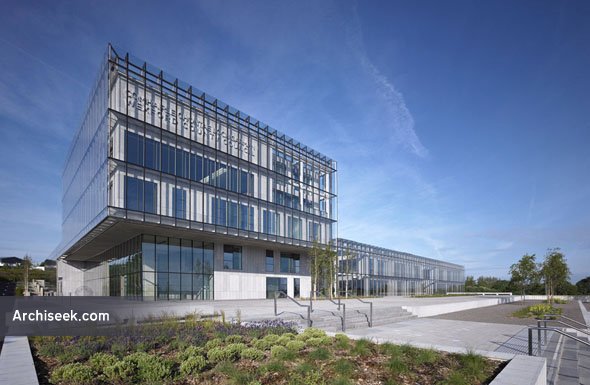2011 – Wexford County Council Headquarters

A modernist pavilion sitting on a limestone plinth atop four broad terraces, the new building forms part of a public-service campus for 3,000 people, which includes the regional hospital and recently built Department of the Environment. This 11,500 sqm building on the outskirts of Wexford town, by Robin Lee Architecture in association with Arthur Gibney and Partners, brings together the services and departments of Wexford County Council for the first time. The accommodation is laid out as a series of six discrete blocks; each block houses key services and individual departments. The blocks are gathered around a large central space, a ‘civic forum’, which gives access to all of the council facilities.
Open and fully accessible, the space supports the way-finding strategy with enquiry desks, public counters and informal seating throughout. It allows the building to be navigated in a safe and efficient manner, while offering opportunities for civic ceremonies, presentations and social gatherings. Separating the blocks, and filled with planting and serene pools of still water, courtyards bring light into the deeper portions of building and connect the interiors with the surrounding landscape, providing a sense of place and context. These spaces combine to place social interaction at the heart of the building and allow the public realm to pervade the whole building at ground floor. Internally walls and floors are clad in Irish Blue Limestone, creating a sculpted interior volume with a calm, refined atmosphere.
An outer layer of glass wraps around the blocks and acts as the outer skin of a double façade. This provides protection on an exposed site but also regulates the interior temperature through the control of air around the building; cooling the building in the summer and creating an insulating layer during the winter. The glass façade is treated uniformly with structurally bonded low iron glass on anodized aluminium mullions to create a sheer envelope that gives the building a single, coherent identity and scale appropriate to its civic status.
Externally the simple but expressive form highlights the entrance via an ‘open mouth’ cut from the corner of the building as the building is approached from the north east. Directly above the entrance corner the building height is increased to give strength and prominent scale to the entrance. At ground floor a large ante-room greets visitors at the entrance and leads them through to the main reception desk situated at the end of the expansive ‘civic forum’. Each of the six department blocks surrounding this space are carved open at one corner to create intimate reception areas which mediate between the public thoroughfare and the secure office spaces that occupy the ground and first floors of each block. Limestone is replaced with a warm palette of oak to mark the threshold to the departmental offices. The blocks are exposed to air and light on three sides via courtyards and the double façade. Floor plates are punctuated with central atriums that facilitate cross ventilation of the open plan offices and allow daylight penetration. Meeting rooms are arranged to face onto the central civic space, encouraging accountability and offering the public glimpses of departmental activity.
The second floor comprises a range of facilities including the staff canteen, the council management suite and the county library headquarters. The canteen is a key social space for the staff and allows for informal meetings within a bright pavilion-like structure, filled with light and with open expansive views to the River Slaney. Bespoke acoustic paneling in oak attenuates the sound to create an intimate environment within the heart of the canteen. To the south and north generously planted terraces occupies the roof and allow the canteen to extend out in fine weather.
The third floor is dedicated to the Council Chamber, accessed via a grand stair formed in European Oak. The Council is composed of 21 elected councillors and is headed by the Cathaoirleach (Chairperson) whose functions are centred round the Council Chamber where monthly meetings of the Council and Council special sub-committees take place. The Council Chamber occupies an elevated position and is dominated by a dramatic panoramic view towards the River Slaney with distant views to Wexford town in the east and the mountains on the Wexford/Carlow and Wicklow borders to the north and west. Conceived as a ‘grand room’, the Council Chamber is a necessarily large volume that accommodates a monolithic oak table, circular in form and democratic. Acoustic wall panels and ceilings and low-level lighting ensure the room has an intimate character that is refined and respectful; a room dedicated to discussion and debate. The fourth and uppermost floor is occupied by a series of individual meeting rooms for Elected Members of the Council who are responsible for deciding policy issues. In this way the Elected Members suite and the Executive suite are located above and below the Council Chamber; with the Council Chamber functioning as the meeting place and decision making forum.
The project was won in an international competition organised by the RIAI in 2006 and is the first building to complete since Lee’s practice Nord LLP was renamed Robin Lee Architecture in April 2011.
PHOTOGRAPHY CREDIT: Andrew Lee








